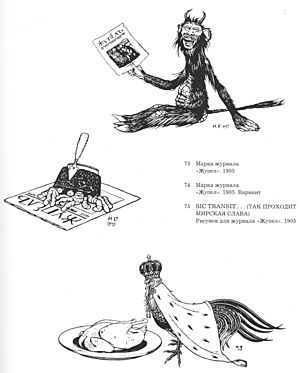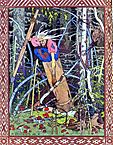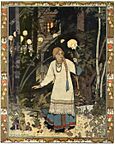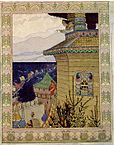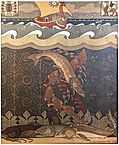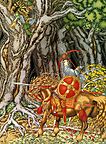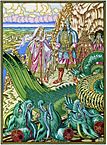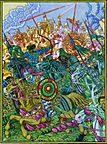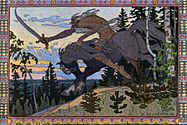Ivan Bilibin facts for kids
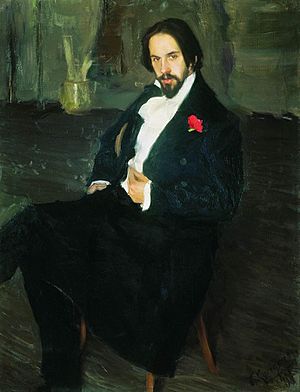
Ivan Yakovlevich Bilibin (born August 16, 1876 – died February 7, 1942) was a famous Russian artist. He was known for his amazing illustrations in books and for designing sets for plays. He was part of an art group called Mir iskusstva (which means "World of Art"). Bilibin became very popular for his drawings in Russian folk tales and stories from Slavic folklore. His art was always inspired by the old art and culture of Rus', which was an early East Slavic state.
Contents
Early Life and Art Training
Ivan Bilibin was born in Tarkhovka, a town near St. Petersburg, Russia. In 1898, he went to study art in Munich, Germany, at the Anton Ažbe Art School. There, he was greatly influenced by a style called Art Nouveau. He also liked the German funny magazine Simplicissimus. After Munich, he studied under a famous Russian artist named Ilya Repin in St. Petersburg. He finished his art training in 1901.
Exploring Russian Folk Art
From 1902 to 1904, Bilibin traveled around different parts of Russia. He visited areas like Vologda, Olonetsk, and Arkhangelsk Governorate. He was doing research on old Russian traditions and looking at examples of wooden buildings. He wrote a book about what he found, called Folk Arts of the Russian North, which came out in 1904. The old art of Russia and traditional Japanese prints had a big impact on his own artwork.
Becoming a Famous Illustrator
Bilibin became an active member of the "Mir Iskusstva" artists' group. He started working on magazines and books in 1899, designing for the Mir Iskusstva magazine itself. He also wrote articles about Russian folk art. He designed for other magazines and publishing houses too.
Bilibin became very well-known in 1899 when he published his beautiful illustrations for Russian fairy tales. During the Russian Revolution of 1905, he drew political cartoons. One of his cartoons, which showed the emperor as a donkey, caused his magazine Zhupel to be banned in 1906. In 1909, he designed the sets for the first show of Nikolai Rimsky-Korsakov's opera The Golden Cockerel.
In 1911, Bilibin was hired to illustrate programs for balls, posters for exhibitions and books, postcards for the Red Cross, and even envelopes with pictures of Russian heroes called Bogatyrs.
Life Abroad and Return to Russia
After the October Revolution in 1917, Bilibin left Russia because he didn't agree with the changes. He wanted to see new places, so in 1920, he went to Egypt. He lived in Cairo and Alexandria, where he painted for the Greek people living there. In Cairo, he focused on art in the Byzantine style, which was popular for icons and church paintings. He also loved the designs and decorations of mosques.
In 1925, Bilibin moved to Paris, France. There, he decorated private homes and Orthodox churches. But he still missed his home country. After decorating the Soviet Embassy in Paris, he returned to Soviet Russia in 1936.
Bilibin died in 1942 during the Siege of Leningrad. He refused to leave the city and sadly starved to death. He was buried in a collective grave with many others.
Family Life
In 1902, Ivan Bilibin married Mary Chambers, who was also an artist and illustrator of children's stories. They had two sons, Alexander and Ivan. Later, in 1912, he married another former student, Renée O'Connell. In 1923, he married the painter Aleksandra Shchekatikhina-Pototskaya. They even had an art show together in Amsterdam in 1929.
Published Works
- Folktales published by the "Department for the Production of State Documents"
- . alt link
- Collections in translated tales :
- , twelve selected illustrations
- , selection from "State Department" work (1899-1902) that includes Sister Alionushka..; Tsarevich Ivan, the Firebird, and the Grey Wolf; The Frog Tsarevna; Vasilisa..; Feather of Finist; White Duck; and Maria Morevna. Main illustrations only
- Illustrations of Pushkin's tales
- , unpublished
- Other
- , unpublished
Gallery
-
Baba Yaga from Vasilisa the Beautiful, 1899
- at www.scumdog.demon.co.uk
See also
 In Spanish: Iván Bilibin para niños
In Spanish: Iván Bilibin para niños


